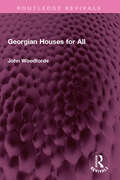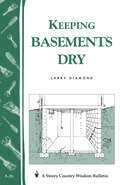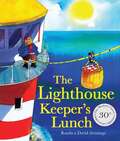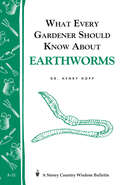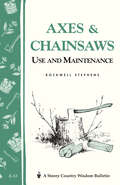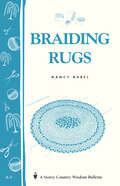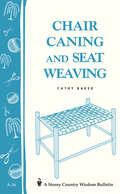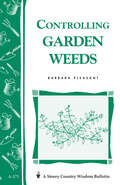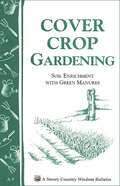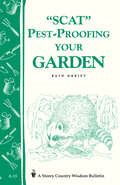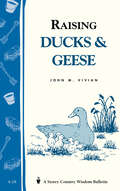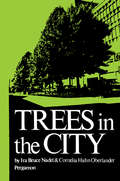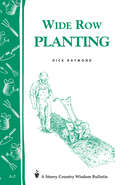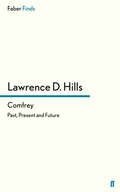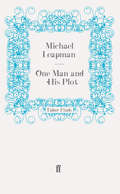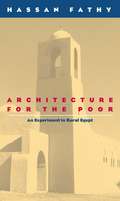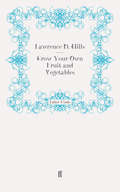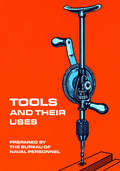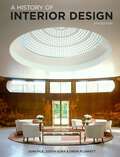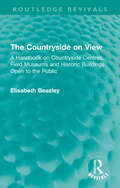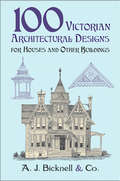- Table View
- List View
Georgian Houses for All (Routledge Revivals)
by John WoodfordeFirst published in 1978, Georgian Houses for All describes how little Gregorian houses came into being and how the original inhabitants used them. Gregorian houses at their smallest and simplest can be seen everywhere in the British Isles – detached, semi-detached and joined together in terraces. There are probably still over a million of them, built during a period of 130 years without the direct aid of architects. John Woodforde points out that an instinctive wish for a symmetrical front seems to be shown by young children’s drawings of houses, these being generally balanced and orderly. The Georgians’ love of symmetry, marked in their way of hanging pictures, was part of a desire for private order amongst public disorder, a desire to have one small sphere in which nature was fully controlled. John Woodforde reminds us that, in the present-day return to terrace-house building, the Georgian version remains a valuable guide. The book will be of interest to students of architecture, urban planning, and history.
Georgian Houses for All (Routledge Revivals)
by John WoodfordeFirst published in 1978, Georgian Houses for All describes how little Gregorian houses came into being and how the original inhabitants used them. Gregorian houses at their smallest and simplest can be seen everywhere in the British Isles – detached, semi-detached and joined together in terraces. There are probably still over a million of them, built during a period of 130 years without the direct aid of architects. John Woodforde points out that an instinctive wish for a symmetrical front seems to be shown by young children’s drawings of houses, these being generally balanced and orderly. The Georgians’ love of symmetry, marked in their way of hanging pictures, was part of a desire for private order amongst public disorder, a desire to have one small sphere in which nature was fully controlled. John Woodforde reminds us that, in the present-day return to terrace-house building, the Georgian version remains a valuable guide. The book will be of interest to students of architecture, urban planning, and history.
Keeping Basements Dry: Storey's Country Wisdom Bulletin A-26 (Storey Country Wisdom Bulletin)
by Larry DiamondSince 1973, Storey's Country Wisdom Bulletins have offered practical, hands-on instructions designed to help readers master dozens of country living skills quickly and easily. There are now more than 170 titles in this series, and their remarkable popularity reflects the common desire of country and city dwellers alike to cultivate personal independence in everyday life.
The Lighthouse Keeper's Lunch (The\lighthouse Keeper Ser.)
by Ronda Armitage David ArmitageAvailable for the first time as an ebook, THE LIGHTHOUSE KEEPER'S LUNCH is a modern classic, loved by children everywhere. Every day the lighthouse keeper tucks into a delicious lunch. But he isn't the only one who enjoys the tasty food. What will stop the greedy gulls from stealing the lighthouse keeper's lunch?
What Every Gardener Should Know About Earthworms: Storey's Country Wisdom Bulletin A-21 (Storey Country Wisdom Bulletin)
by Henry HoppSince 1973, Storey's Country Wisdom Bulletins have offered practical, hands-on instructions designed to help readers master dozens of country living skills quickly and easily. There are now more than 170 titles in this series, and their remarkable popularity reflects the common desire of country and city dwellers alike to cultivate personal independence in everyday life.
Axes & Chainsaws: Use and Maintenance / A Storey Country Wisdom Bulletin A-13 (Storey Country Wisdom Bulletin)
by Rockwell StephensSince 1973, Storey's Country Wisdom Bulletins have offered practical, hands-on instructions designed to help readers master dozens of country living skills quickly and easily. There are now more than 170 titles in this series, and their remarkable popularity reflects the common desire of country and city dwellers alike to cultivate personal independence in everyday life.
Braiding Rugs: A Storey Country Wisdom Bulletin A-03 (Storey Country Wisdom Bulletin)
by Nancy BubelBraided rugs are like family quilts – each strip of cloth comes from a cast-off garment and tells a story all its own. Piecing the rug together is an act of weaving family memories into a useful heirloom you'll treasure forever. Nancy Bubel covers every step of the simple process, from planning the perfect size, shape, and color scheme to cutting your cloth strips, braiding them together, and finishing off your rug.
Chair Caning and Seat Weaving: Storey Country Wisdom Bulletin A-16 (Storey Country Wisdom Bulletin)
by Cathy BakerSince 1973, Storey's Country Wisdom Bulletins have offered practical, hands-on instructions designed to help readers master dozens of country living skills quickly and easily. There are now more than 170 titles in this series, and their remarkable popularity reflects the common desire of country and city dwellers alike to cultivate personal independence in everyday life.
Controlling Garden Weeds: Storey's Country Wisdom Bulletin A-171 (Storey Country Wisdom Bulletin)
by Barbara PleasantSince 1973, Storey's Country Wisdom Bulletins have offered practical, hands-on instructions designed to help readers master dozens of country living skills quickly and easily. There are now more than 170 titles in this series, and their remarkable popularity reflects the common desire of country and city dwellers alike to cultivate personal independence in everyday life.
Cover Crop Gardening: Soil Enrichment With Green Manures/Storey's Country Wisdom Bulletin A-05 (Storey Country Wisdom Bulletin)
by Editors of Storey PublishingGreen manuring – the growing and turning under of cover crops to fertilize and improve your soil – is one of the best things you can do for your garden. This practice eliminates the need for chemical fertilizers and nitrogen, helps unlock nutrients in the soil, cuts down on weeds, increases the number of beneficial organisms in your soil, and improves your soil&’s ability to hold water. The result is that you spend less time, energy, and money while enjoying a healthier, more productive, and more attractive garden. This concise guide introduces you to the primary methods of green manuring and shows you how to select your cover crops, how to plant them, and when and how to turn them under.
Pest-Proofing Your Garden: Storey's Country Wisdom Bulletin A-15 (Storey Country Wisdom Bulletin)
by Ruth HarleySince 1973, Storey's Country Wisdom Bulletins have offered practical, hands-on instructions designed to help readers master dozens of country living skills quickly and easily. There are now more than 170 titles in this series, and their remarkable popularity reflects the common desire of country and city dwellers alike to cultivate personal independence in everyday life.
Raising Ducks & Geese: Storey's Country Wisdom Bulletin A-18 (Storey Country Wisdom Bulletin)
by John VivianSince 1973, Storey's Country Wisdom Bulletins have offered practical, hands-on instructions designed to help readers master dozens of country living skills quickly and easily. There are now more than 170 titles in this series, and their remarkable popularity reflects the common desire of country and city dwellers alike to cultivate personal independence in everyday life.
Trees in the City: Habitat: a Series of Texts on All Aspects of Human Settlements
by Ira Bruce Nadel Cornelia Hahn Oberlander Lesley R. BohmTrees in the City provides an introduction to the process of humanizing the cityscape and guide to planting trees in city conditions. This book focuses on four basic concepts. First, trees play an essential role in human's urban life. Second, people must become aware of the environmental, esthetic, social, and political importance of trees. Third, trees need to be integrated with the pattern and function of urban activity. Finally, the design, placement, and maintenance of trees on city streets are the responsibility of everyone in the community. The topics discussed include a short history of trees in the city; environmental and esthetic relation of trees, human, and the city; tree choices and features; and designing a city street—models, problems, and matrixes. This publication is beneficial to landscape architects and individuals interested in tree planting in urban areas.
Wide Row Planting: Storey's Country Wisdom Bulletin A-02 (Storey Country Wisdom Bulletin)
by Dick RaymondSince 1973, Storey's Country Wisdom Bulletins have offered practical, hands-on instructions designed to help readers master dozens of country living skills quickly and easily. There are now more than 170 titles in this series, and their remarkable popularity reflects the common desire of country and city dwellers alike to cultivate personal independence in everyday life.
Comfrey: Past, Present and Future (Conservation Gardening And Farming Ser. #Ser. C)
by Lawrence D. HillsComfrey is noted by both organic gardeners and herbalists for its great usefulness and versatility. Of particular interest is the 'Bocking 14' cultivar of Russian Comfrey. This strain was developed during the 1950s by Lawrence D. Hills, who founded the organic gardening organization now known as Garden Organic.Lawrence D. Hills was the world authority on comfrey. In this book, he wrote for farmers and gardeners in all countries, showing how this useful plant could be cultivated in both tropical and temperate zones to produce a crop equally rewarding for gardener, smallholder and mechanized farmer. Subtitled 'Past, Present and Future,' on its publication in 1976, this was the most comprehensive survey of the properties and cultivation of comfrey ever, and Comfrey remains undoubtedly the essential book on the subject, as well as a lasting testament to Lawrence D. Hills's indefatigable efforts to achieve a better understanding of it.
One Man and His Plot
by Michael LeapmanWriter of The Times Diary, Michael Leapman, became a tenant of an allotment next to Brixton Prison for 35p a year in 1974 when food and energy shortages inspired many people to attempt self-sufficiency. This book tells the story of the plot and the author's first year of cultivating it, written with humour and wit while providing a wealth of information for the would-be urban horticulturalist."It is splendid stuff and if your husband is a gardening bore and you want to shut him up for an hour or three, this is the answer.' The Guardian'It makes fine bedside reading, laced with plenty of anecdotes, good gardening information, plus an Idle Gardener's Almanac.' Good Housekeeping
Perspektive und Axonometrie
by Reiner ThomaeNoch immer ist die Kenntnis und die Lehre von der Perspektive für die räumliche Darstellung geplanter Objekte unentbehrlich. Dies wird sich trotz Fotografie und Computer-Aided-Design (CAD) nicht ändern. Das Buch erklärt das Wesentliche zur Perspektive anhand leicht verständlicher Beispiele, wobei die Zeichnung im Mittelpunkt steht, ergänzt um knappe Erläuterungen. Diese Perspektivlehre ist vor allem für diejenigen gedacht, die sich mit der Planung neuer Objekte befassen - für Architekten und Designer, aber auch für den interessierten Laien. Vorkenntnisse sind nicht erforderlich.
Architecture for the Poor: An Experiment in Rural Egypt
by Hassan FathyArchitecture for the Poor describes Hassan Fathy's plan for building the village of New Gourna, near Luxor, Egypt, without the use of more modern and expensive materials such as steel and concrete. Using mud bricks, the native technique that Fathy learned in Nubia, and such traditional Egyptian architectural designs as enclosed courtyards and vaulted roofing, Fathy worked with the villagers to tailor his designs to their needs. He taught them how to work with the bricks, supervised the erection of the buildings, and encouraged the revival of such ancient crafts as claustra (lattice designs in the mudwork) to adorn the buildings.
Architecture for the Poor: An Experiment in Rural Egypt
by Hassan FathyArchitecture for the Poor describes Hassan Fathy's plan for building the village of New Gourna, near Luxor, Egypt, without the use of more modern and expensive materials such as steel and concrete. Using mud bricks, the native technique that Fathy learned in Nubia, and such traditional Egyptian architectural designs as enclosed courtyards and vaulted roofing, Fathy worked with the villagers to tailor his designs to their needs. He taught them how to work with the bricks, supervised the erection of the buildings, and encouraged the revival of such ancient crafts as claustra (lattice designs in the mudwork) to adorn the buildings.
Grow Your Own Fruit and Vegetables
by Lawrence D. HillsGrow Your Own Fruit and Vegetables is Lawrence D. Hills's ground-breaking book on all aspects of fruit and vegetable growing. It was widely praised on its publication and remains a classic text in the world of organic gardening.'Its great merit is that one feels that every operation described has been personally carried out by the author and selected as the most satisfactory after due consideration of traditional methods. The treatment of each plant is described from start to finish with sense, relish and humour; there are many fascinating analyses of vitamin and mineral contents and nutritional values, of different vegetables and fruits; and there is excellent advice on picking, harvesting, as well as on cooking ... it is the best practical guide to the subject that has appeared for years, and the author is not concerned with argument or philosophy, only with growing produce well.' Country Life'There is no better guide to non-chemical gardening than Lawrence D. Hills ... He is exceptionally well read and a good practical gardener into the bargain, not a very common combination, and no doubt because of his wide-ranging knowledge he is more balanced in his views than some advocates of all-organic gardening ... Where I find Mr Hills most stimulating is in his highly personal approach to fruit and vegetable varieties and his recommendations based on such commercially unfashionable criteria as flavour and food value. There is a wealth of information here which would be difficult to find in any other single book.' A. G. L. Hellyer in the Financial Times
Tools and Their Uses
by U.S. Bureau of Naval PersonnelDo you have trouble with tools — find that they wear out too quickly, find that you can't decide which tools to buy or which tools to use for a specific job, find that little things continually go wrong? The only way to learn to use tools, of course, is by using them, but first you have to know which tools to use and why.This manual, originally prepared for the use of naval personnel, was designed to present the basic hand and power tools that the ordinary person is likely to use. Through a wealth of diagrams, clear explanations, safety tips, and operating instructions you will soon learn the basics of choosing tools and using them as they were meant to be used. Nearly every hand tool you are likely to use around the house is described in the first chapter: hammers, wrenches, screwdrivers, wood saws, planes, wood chisels, metal chisels, dies, drills, files, hacksaws, punches, reamers, taps, clamps, vises, pliers, knives. Chapter two covers the common power tools: drills, grinders, sanders. Chapter three covers measuring tools from rules and tapes to calipers, micrometers, and squares with detailed instructions on how to use each one. Chapter four describes the common nails, screws, bolts, nuts, rivets, and other fasteners you are likely to use. Chapter five describes grinders and shows how to sharpen and care for screwdrivers, chisels, drills, and snips. The final two chapters cover such miscellaneous tasks and tools as metal cutting operations, stripping insulated wire, and soldering techniques.By the time you finish you should know the names, general uses, and correct operation of all the basic tools, fasteners, and measuring devices you are likely to need around the house. You should be able to select tools for a basic kit for doing simple home repairs. And you should be confident in beginning to use tools for yourself to perform all those simple but necessary repair jobs.
A History of Interior Design Fifth Edition
by John Pile Judith Gura Drew PileA History of Interior Design tells the story of 6,000 years of domestic and public space. It's an essential resource for students, professionals and anyone interested in interior design, the decorative arts, architecture and art history. It explores a broad range of styles and movements, weaving together a fascinating narrative from cave dwellings and temple architecture, through Gothic cathedrals and Islamic palaces, to modern skyscrapers and the retail spaces of the 21st-century.This fully updated fifth edition includes more on the contributions of women designers and architects, additional coverage of furniture, product design and decoration, as well as numerous examples of diverse modern styles from around the world. An extra final chapter focuses on the influence of the latest technology and current thinking on the importance of conservation and ethical sourcing.This new edition includes 730 images, over 300 of which are new or colour replacements for black and white photos.
The Countryside on View: A Handbook on Countryside Centres, Field Museums and Historic Buildings Open to the Public (Routledge Revivals)
by Elisabeth BeazleyOriginally published in 1971 The Countryside on View is a handbook which provides extensive information about the many ways in which visitors to rural areas may find out about what they have come to enjoy. A major part of it concerns small countryside centres which house information services and which are designed to give both the casual visitor and organised educational parties a deeper understanding of the place they have come to see. The book also has chapters on the techniques involved in the showing of historic monuments and buildings, from lonely cromlechs and romantic ruins to churches, house, bridges and other structures which are still in use. A pioneering work in the field of Museum Studies.
The Countryside on View: A Handbook on Countryside Centres, Field Museums and Historic Buildings Open to the Public (Routledge Revivals)
by Elisabeth BeazleyOriginally published in 1971 The Countryside on View is a handbook which provides extensive information about the many ways in which visitors to rural areas may find out about what they have come to enjoy. A major part of it concerns small countryside centres which house information services and which are designed to give both the casual visitor and organised educational parties a deeper understanding of the place they have come to see. The book also has chapters on the techniques involved in the showing of historic monuments and buildings, from lonely cromlechs and romantic ruins to churches, house, bridges and other structures which are still in use. A pioneering work in the field of Museum Studies.
100 Victorian Architectural Designs for Houses and Other Buildings (Dover Architecture)
by A. J. Bicknell Co.Originally published in 1878, this now-rare collection of designs supplies views of a remarkable variety of modestly priced structures: houses, villas, cottages, many others. Handsome drawings of perspective views and elevations, some of which include floor plans, plus suggestions for interior design. 98 black-and-white illustrations.
